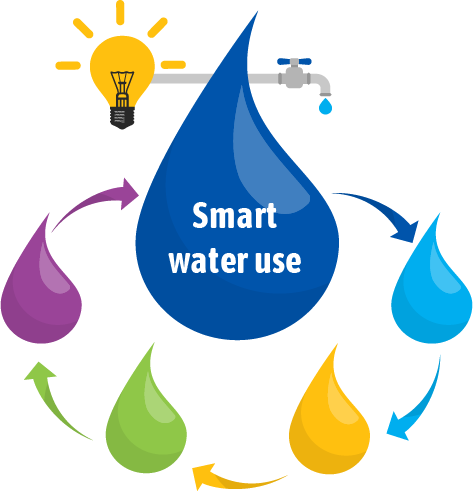ACTIVITY
Being smart with water
Activity Idea
In this activity, students use knowledge, skills and the research and information from their inquiries to make a difference and learn how to be smart with water use.
By the end of this activity, students should be able to:
- plan for a water saving action
- participate in an action that reduces water use or addresses a water-related issue.
What you need
- Being Smart With Water - Activity 9 doc
- Student handout Water saving actions in the bathroom
- Student handout Water saving actions in the kitchen
- Student handout Water saving actions at school and outdoors
- Student handout Thinking about action
FOR TEACHERS
Introduction
This activity is ideally done as the final activity in the Smart Water inquiry.
What is environmental action?
Environmental action is part of a process of inquiry learning where students plan and carry out a meaningful task that addresses an environmental issue. For example, action in this context would save water or reduce pollution, such as fixing a leak, installing a low-flow shower head, taking shorter showers or planting natives by a stream.
Kaitiakitanga for freshwater
We can appreciate that water is a taonga (a treasure of immense value) that needs to be looked after, protected and treasured. After learning about water issues and thinking about the future consequences, it is helpful for students to follow up their inquiry by participating in a water saving action.
Collaborative community action
To achieve sustainable development outcomes, a whole-catchment approach works best. Partnerships are very important with this approach, because if a whole catchment is not involved, alternatives and solutions can be ineffective. It takes a whole community to keep water healthy.
Collaborative action involves multiple groups of people and distributes responsibilities and tasks. All parties should be involved in decision making and planning. Working with others, we can achieve more, and the burden of environmental problems is shared rather than being on the shoulders of individuals. Collaborative actions can be impactful and far-reaching, but they do require good communication, organisation and energy.


Additional resources and organisations who can help
These resources reinforce and build on learning about participating and contributing and action:
- What action can we take? – video and supporting resources
- Global action – Connected level 4 article
- The ‘Participating and contributing’ strand – PLD article
- Taking action for conservation – PLD webinar
Links to organisations who can help with action in the Waikato region:
- Smart Water – Hamilton City Council site with water saving tips and more
- Enviroschools – an action-based whole-school environmental programme for schools
- The Fairfield Project – Kirikiriroa Hamilton-based environmental education project
- Waikato coastcare groups – protecting coastal ecosystems
- New Zealand Landcare Trust – catchment management to improve land and water quality
Water actions and ideas - water saving posters
1. View the water saving action ideas for the bathroom, kitchen and school and outdoors. Students can use these posters for inspiration about actions. They can then design their own posters, websites or blogs to share their learning about water issues and how people can be more water efficient.
Smart Water quiz
2. Try the Smart Water shower and electricity quiz to see how much water efficiency is happening at your place.
Investigate restoration efforts of local organisations
3. View the Waikato River Authority videos:
4. Discuss how iwi, landowners and other groups are working to improve the health and water quality of rivers. How can we contribute to these efforts to restore the health of our rivers?
Planning for action
5. Review the responses students have made while using Smart Water: Inquiry plan and student reflection – slideshow.
6. Reflect on learning from your class inquiry and think about how students could contribute to water conservation. Students may choose to change a behaviour that would help to save water. This could be an individual action inspired by the posters they made or they may want to address a bigger issue collaboratively with the local community. Form a plan that fits the resources and time you have available. The student handout Thinking about action leads you through the action-planning process. In groups, students can complete the student handout, recording their ideas about meaningful actions that will enable them to be smarter with water use and/or address water issues in the community.
7.Remember to share your actions and communicate with the school community about how you are being smart with water use and/or helping to restore local water bodies. Think about how your action could be monitored and built upon so that all your hard work doesn’t go to waste.
Questions to deepen student understanding
- What does sustainable use of water mean?
- Is it the same for all communities?
- What would sustainable water use look like in Waikato?
Reflecting on learning
- Discuss what went well with your action and reflect on the challenges you faced.
- Describe how your action made a difference for the focus issue.
This activity is part of a suite of resources that support Smart Water – a context for learning, which provides students and teachers with opportunities to connect with water and learn more about drinking water in the Waikato region. The science and mātauranga concepts that underpin Smart Water are transferable to other locations in Aotearoa New Zealand. Smart Water is a partnership between Hamilton City Council, Waipā District Council and Waitomo District Council. It aims to foster a greater understanding and appreciation of water from source to tap and supports schools, organisations and communities to use water sustainably.
For students
Water saving actions in the bathroom

Water saving actions in the kitchen

Water saving actions at school and outdoors

Thinking about action

